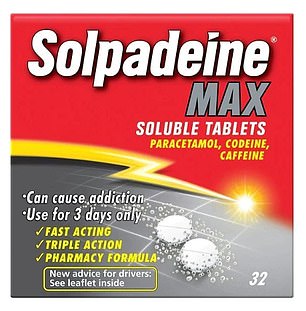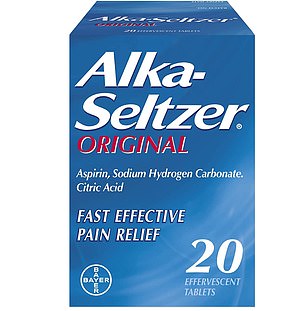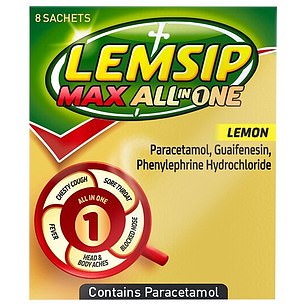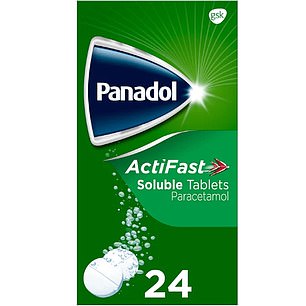Forget McDonald’s! Paracetamol can contain as much salt as 21 PORTIONS of fries
>
You’re probably well aware of the salt lurking in McDonald’s French fries or a packet of potato chips.
But did you know that over the counter medications can be even worse?
For example, if you eat the RDA of the saltiest ones, you’re getting the same amount of sodium you’d find in 21 small servings of French fries.
Experts are warning the millions of people who buy soluble versions of painkillers, which are the worst, to be careful because their salt levels can be “dangerously high.”
You may already be aware of the hidden salt lurking in fast food, but some over-the-counter medications could be even worse for your heart. Experts caution those buying soluble or effervescent versions of the pain reliever to check their sodium content first. All of the above medicines are available without a prescription, with the exception of Zentiva Co-Codamol 8/500 effervescent tablets, which are only available by prescription.
Sodium, one of the main components of salt, is commonly used in soluble medicines. It is added to allow the tablets to dissolve in water.
The NHS recommends that adults consume no more than 2.4g of sodium per day, the equivalent of 6g of salt or around a teaspoon. Experts say that salt is about two and a half times the amount of sodium.
Similarly, guidelines in the US state that adults should also limit their sodium intake to 2.3g.
In the UK, all medicines that contain at least 1 mmol (or 23 mg) of sodium in each dose are required to declare this on their labeling.
The accompanying patient information leaflet provides information on the amount of sodium and includes a warning for patients on a low sodium diet to consider how much is hidden in their medicine.
Several brand name medications, such as Panadol, Solpadeine, and Alka-Seltzer, can exceed the recommended daily salt limit.
Alka-Seltzer Original 20 effervescent tablets contain 477 mg of sodium per tablet.
If the maximum recommended daily dose of two tablets is taken four times a day, a person would consume 3.8 g (3816 mg) of sodium from the tablets alone.
This is more than one and a half times the recommended sodium intake for an adult.
It’s also the equivalent of 21 servings of McDonald’s small fries (approximately 176 mg per serving), nearly four Big Macs (1056 mg), or 28 packets of Walkers Salted Fries (136 mg).
Equally high levels were seen in Panadol Paracetamol Pain Relief Tablets 500 mg ActiFast Soluble 24s (427 mg) and Solpadeine Max Soluble Tablets (427 mg).


A MailOnline audit found that Solpadeine Max soluble tablets contain 427mg of sodium per tablet, 18 percent of your recommended daily intake. Meanwhile, the main offender Alka-Seltzer Original 20 Effervescent Tablets reports a total sodium content of 477 mg.
In addition to being overweight, consuming too much salt is one of the main causes of high blood pressure, which can lead to heart disease.
Heart disease is one of the leading causes of death in Britain, causing 160,000 deaths from stroke, heart attack and heart failure each year, around one every three minutes.
In the US, heart disease alone kills 660,000 Americans a year, accounting for a quarter of all deaths.
Acetaminophen 500 mg daily tablets contain less than 1 mmol sodium, or 23 mg, per tablet, making them effectively “sodium-free.”
But among the brands of effervescent paracetamol available, Cipla Paracetamol 500mg Effervescent Tablets Pack of 24 was found to contain 463.01mg sodium per tablet.
Max Remedies 24 Paracetamol Effervescent Tablets 500mg followed closely with 438mg.
But it’s not just paracetamol.
Lemsip Max All in One Lemon was also found to contain 129 mg of sodium per sachet.
If the maximum recommended daily dose of one sachet is taken four times a day, a person would consume 0.52 g of sodium, or 22% of the recommended daily intake.
Beechams Flu Plus Lemon 10s reports a total sodium content of 120mg per sachet.
Among private label retail medications, Boots max force for cold and flu relief also contains 118 mg of sodium per tablet.
Experts recommend aspirin tablets or soluble aspirin as a good alternative to high-sodium effervescent medications, since neither aspirin tablets nor soluble aspirin contain salt.
But health advisers say no one should panic and throw away prescription drugs, but instead speak to a GP or pharmacist first.


Effervescent medications have a higher sodium content, since they work faster in liquid form and are absorbed more quickly by the digestive system than a standard tablet. Lemsip Max All in One Lemon was found to contain 129mg sodium per sachet, while Panadol Paracetamol Pain Relief Tablets 500mg ActiFast Soluble 24s reports a total of 427mg per tablet.
Sonia Pombo, nutritionist and Action on Salt campaign manager, told MailOnline today: “It’s ironic to think that while we may be taking soluble medicines to help us, we are unknowingly causing unnecessary harm to our health.”
“These medications are dangerously high in sodium and would provide us with more than 9 g of salt equivalent in a day, more than 60 percent above our daily upper limit.”
She added: ‘Eating too much sodium, in any form, increases our blood pressure, putting us at greater risk of strokes and heart attacks.
“Pharmaceutical companies should do more to clarify this, as without a clear label on these products, it’s impossible to know how much extra sodium we might be consuming.
“If possible, avoid effervescent or soluble medications, which contain sodium to help them dissolve in water, and opt for non-soluble versions.
“But if you have any questions about what’s in your medicines, read the label for more information and talk to your pharmacist or GP.”
Sindy Jodar, Senior Cardiac Nurse at the British Heart Foundation, also told MailOnline: “Effervescent and soluble formulations of paracetamol can contain significant amounts of sodium in each tablet, and the maximum daily dose of these types would exceed the daily intake of 2 g sodium recommended by the World Health Organization.
If you take paracetamol containing sodium occasionally to control an isolated headache or very brief episodes of pain, then you should not worry unnecessarily.
It comes as a 2022 study published in the European Heart Journal revealed that patients taking the high-sodium versions of soluble acetaminophen tablets were up to 45 percent more likely to have a heart attack, stroke or heart failure within a year.
He also advised that chief health officers should consider adding health warnings to the sodium-containing acetaminophen to warn patients of the dangers.
A landmark 2013 study also found that patients taking effervescent, dispersible and soluble sodium-containing drugs were also seven times more likely to develop high blood pressure and had a 22 percent increased risk of stroke.
Professor Jacob George, Professor of Cardiovascular Medicine and Therapy at the University of Dundee, a co-author of the study, told MailOnline today: “Add to this our Western diets and the salt in processed foods and you can easily see how many people are taking these drugs.” long-term they are consuming excessive amounts of salt.’
| pain medication | sodium content |
|---|---|
| Alka-Seltzer Original 20 Effervescent Tablets | 477mg per tablet |
| Alka-Seltzer XS 20 Effervescent Tablets | 472mg per tablet |
| Cipla Paracetamol 500mg Effervescent Tablets Pack of 24 | 463mg per tablet |
| Max Remedies Effervescent Paracetamol 24 Effervescent Tablets 500mg | 438mg per tablet |
| Solpadeine soluble tablets for headache | 427mg per tablet |
| Panadol Extra Soluble paracetamol caffeine analgesic pills x24 | 427mg per tablet |
| Panadol Paracetamol Pain Relief Tablets 500mg ActiFast Soluble 24s | 427mg per tablet |
| Solpadeine Max Soluble Tablets | 427mg per tablet |
| Zentiva Co-Codamol 8/500 Effervescent Tablets | 388mg per tablet |
| Ultramol Soluble Tablets 32 Tablets | 388mg per tablet |
| Lemsip Max All in One Lemon – 8 Envelopes | 129mg per sachet |
| Beechams Flu Plus Lemon 10s | 120 mg per sachet |
| Boots Pharmaceuticals Max Strength Cold & Flu Relief Lemon Flavored Powder for Oral Suspension – 10 Sachets | 118mg per sachet |
| Nurofen Pain Relief 256mg tablets | 24.3mg per tablet |
